The Lost Chambers and the lost world at Atlantis The Palm Dubai
Share post
When I was a kid, I read “20,000 leges under the sea” by Jules Verne. I traveled with Captain Nemo and his submarine through the lost ruins of Atlantis, and the adventure fascinated me!
Atlantis (the island of Atlas), says Plato (the first to mention it in 360 BC), is a legendary island with a circular structure in the center, near the sea, at 4,988 km from Athens. The area would include a part of Europe, Africa and the Middle East. The philosopher describes in his writings a land of unprecedented beauty, an extremely advanced culture and an unusually educated population, of all four human races: white, red, yellow and black. Atlantis coexisted for several million years with Lemuria, a continent stretching across the current Pacific Ocean and Indian Ocean, and part of Africa and today’s Europe.
The possible existence of a real Atlantis has been intensely debated. A little known in the Middle Ages, the legend has been rediscovered by humanists in modern times. Currently, Atlantis’s motive is extremely well-known, from science fiction to video and video games, to aquariums inspired by the lost world and probably sank by the tsunami caused by a strong earthquake following the eruption of an underwater volcano.

The Lost Chambers Aquarium at Atlantis The Palm Hotel Dubai rebuilds the underwater décor of the submerged continent and visitors can walk through 10 rooms with wonderful artefacts of lost civilization, admiring stunning aquariums with over 65,000 creatures.

From the entrance to the right is Navigation Room, the place where the leaders made plans for research, travel, set teleporter coordinates or traditional means of moving into air or water. It is said that they used arapa fish to consult maps, as this species has the ability to navigate through freshwater channels of various depths, just like in their South American lands.
Arapaima is one of the largest species of freshwater fish, can reach 3 meters in length and weighs up to 90 kg. Due to excessive fishing for meat and the language that appears to have medicinal properties, the species is endangered.
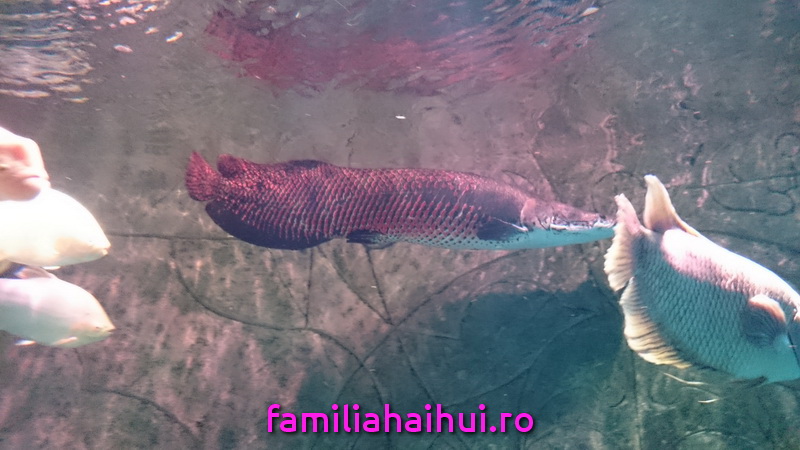
Arapaima
We then go to Knowlegde Room, where we find more Jellyfish Aquariums and a Knowledge Room Telephone next to the communication portal where the jellyfish were installed. The Sages of the old continent stood here to communicate with the outside world.
Jellyfish are among the oldest species in the world, over 600 million years. Their body composition is mostly water, they have no eye or brain. They live between 6 months and 2 years in a natural climate and more in captivity as they are not subject to seasonal temperature changes, storms, strong currents or torrents such as turtles. Many species are carnivorous, feeding on zooplankton, microscopic animals, and even jellyfish.
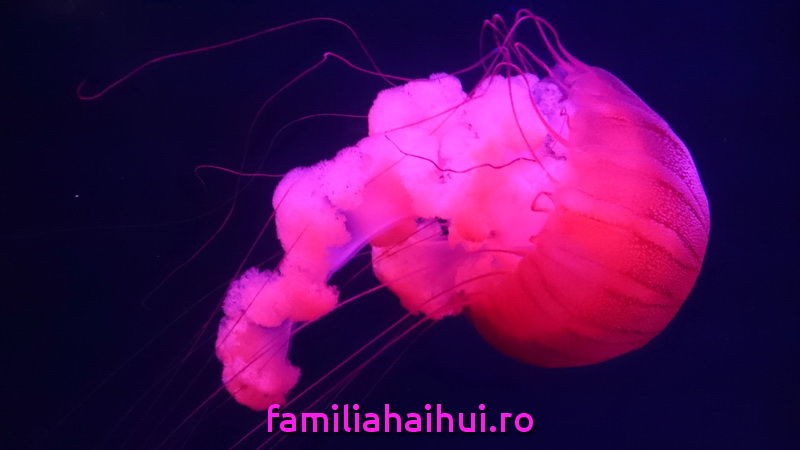
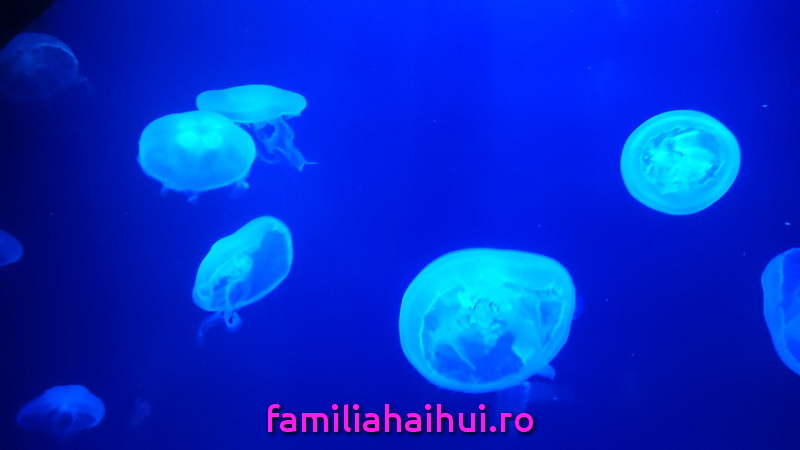
In Technology Center we discover an ancient but sophisticated banking system that served on personal and commercial transactions with the standard Atlantic currency, the blue crystals.

Here we encounter the eeals (Honeycomb Moray Eel), nocturnal animals, considered blind during the day. When they open their mouth openly they seem to be threatening, but they actually breathe: with their mouth open, they pump water and extract the necessary oxygen. They are shy and withdrawn and attack only when they want to defend themselves.

We then go to a round room called the Abyss. From here, it was going to me, looking for precious minerals and treasures, especially crystals – the main source of energy. There was a kind of bronze and leather elevator, and the miners were wearing special diving suits that allowed them to work in the deep.
Here we find the friendly alibi aligator. The albino animals are extremely rare, have all the characteristics of their species but lack melanin or pigment in the skin. They have a milky white color and eyes that look pink.
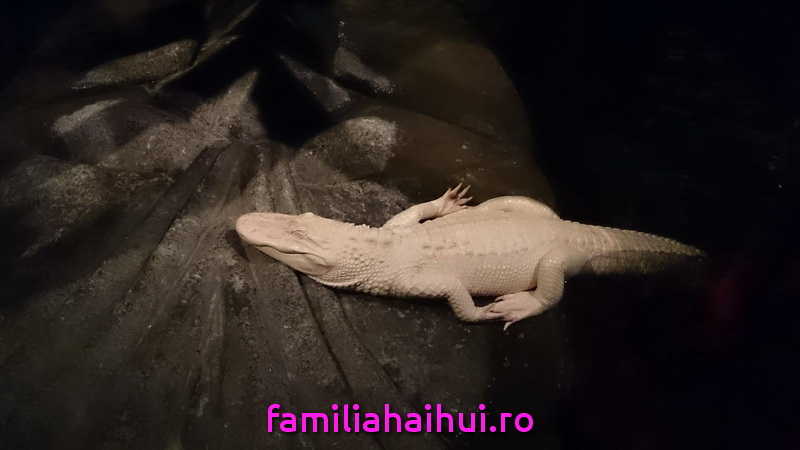
We’re going to the Red Sage Chamber, the room used for astronomical studies. Here are The Astronomical Chair and Telescopic Mask, used to study the stars. The wall-painted calendar describes the cycles of the day, the rain, the tides and the spring season.
Here is Red tail catfish, which swims on the bottom of the water. Musts help him find food under reduced visibility. Originally from South America, this freshwater species exists on earth for about 13 million years.
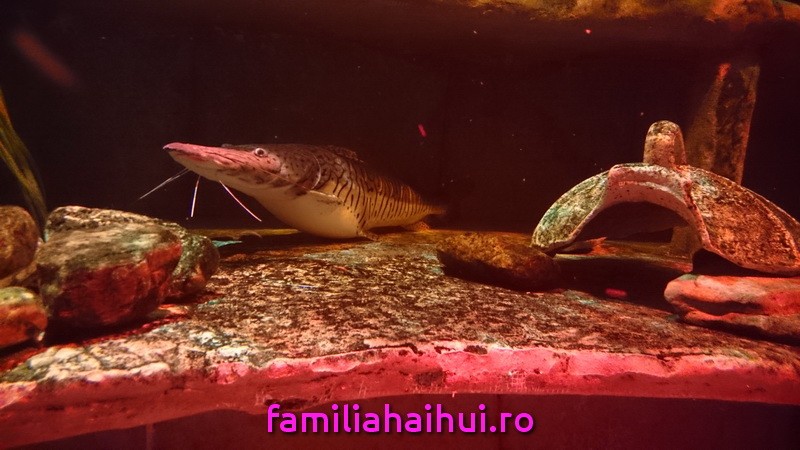
Seven Sages Chamber shelters the remains of an organic computer, based on the energy of the crystals that surrounded it. The ancient rulers came here to load the data extracted from their exploration and research programs.
The children touched the crustaceans, namely the Horseshoe Crab, named so because of the hard horseshoe shaped shell that protects its internal organs. Although it is a crab species, it appears to be closer to spiders and scorpions. His blood uses hemocyanin rather than hemoglobin to carry oxygen molecules, hence the high level of copper that gives it the blue color.

Blue Sages Chamber was the martial arts training center that the Atlantians taught for self-defense and where they were preparing for battles when attacked. For defense, the leaders took inspiration from the piranha (the symbol of battle) and built the Bone-sword, Bow of Anshan and Might of Heroes Axes.
Piranha (Red bellied piranha) is also a freshwater species commonly found in the South American rivers, such as the Amazon. There are 12 species of piranha, of which 5 are considered dangerous for humans. Amazon locals call them “pee-ran-ya”, that is, scissor teeth. Although most species eat fruit, seeds and other fish, fragments of birds, snakes and small mammals have been found in the stomachs of piranha fish.

The Workshop is exactly what his name says, a workshop where most of the gears and artifacts in the lost rooms were made.
Here we meet Queensland Grouper, one of the largest heavy fish species in the family of sea urchins, with a large head and a wide mouth. It lives up to 40 years in hot seas, can reach up to 400 kg. What is interesting: most fish of this species are born females, and when they reach maturity, for unknown reasons they become males.

The penultimate room, Generator Room, was the room where all the energy of the crystals was stored to feed the whole Atlantis continent. The generator itself was located at the bottom of the room, and the energy produced flowed through some tubes.
Here we see species of coral and multicolored fish. Few know that the coral reef occupies about 1% of the Earth’s surface and shelters 25% of fish species. The first reef appeared 500 million years ago. Already a quarter of it has disappeared, and it is estimated that two-thirds of what remains are at risk.

The last room is, predictable, the souvenir shop. We draw attention to inappropriate gifts that harm the environment and endangered species. Trade in turtle, coral, sea bass shells (forget how beautiful they are in the gallery below) and shells is illegal and yet black market demand still exists.
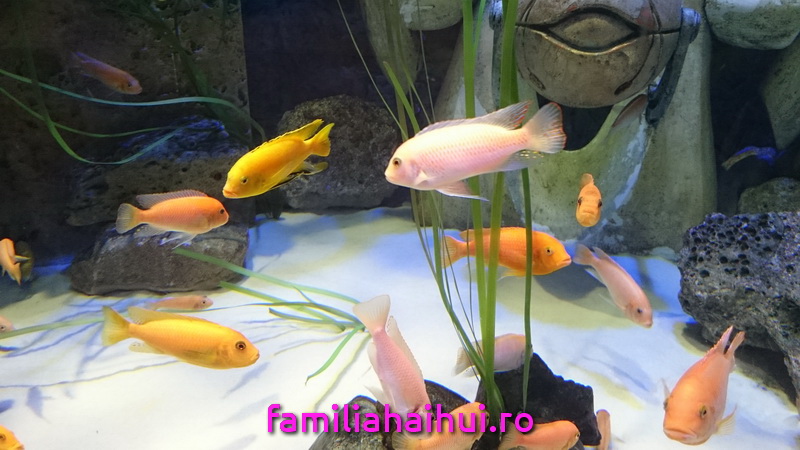
The immense aquariums of Atlantis the Palm Dubai are the delight of visitors and guests of the hotel, but behind there is a whole industry of care and protection. The thickest acrylic panel in Poseidon’s yard measures 77 cm, even though the fish that swim there seem so close to you. Inside the aquariums there is an extended 5.9km of tubing and pipe network, larger even than the length of the Palm itself. 350 kg of food is prepared daily for animal meals in aquariums.
In addition to visiting the Lost Chambers itself, visitors can also opt for a lot of extra expensive but memorable activities such as Aquatrek, Behind the Scenes Tour, Predator Dive, Ultimate Snorkel, Shark Safari, Cownose Ray feeding.
The aquarium is open for daily visits from 10am to 10pm, for more information and reservations you can access directly the hotel website.
More beautiful photos can be found in the gallery below.
Click here if you want to read Aquaventure Water Park description, one of the best water parks in the world, in our opinion.


